Category: 隧道掘进业的未来发展
隧道掘进行业的改变: ITA的角色、 伙伴关系和创新成果
1970年,Martin Knights 毕业于土木工程专业,并作为他的第一个隧道掘进机项目,在英国利物浦的Mersey公路隧道工程中担任现场工程师。这条2.5英里长的双隧道工程的主要特点是采用了翻新的直径35英尺罗宾斯掘进机,它曾在巴基斯坦的曼格拉水坝上驱动了一些供水隧道。几十年来,Knights曾在几家咨询公司工作过,在几十年里参与过一些重要的隧道工程项目,最近他也担任CH2M / Halcrow公司的总经理兼副总裁。他也是2007 – 2010年国际隧道协会(ITA)的主席。他目前是自己公司的独立顾问,Martin Knights咨询公司。
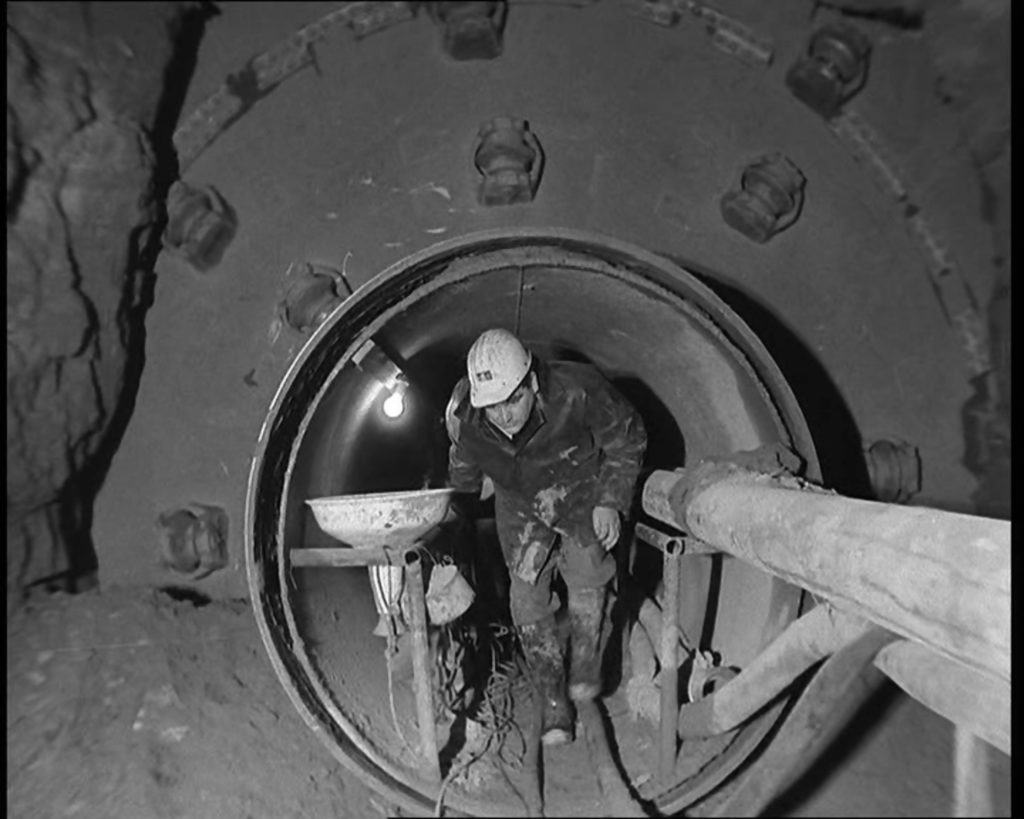
一名工人正在英国的默西公路隧道项目翻修的罗宾斯掘进机里。默西路隧道是Knights在1970年毕业后的第一个隧道掘进机项目。 摄影: British Pathé
最近,在挪威卑尔根举行的ITA培训课程上,我做了一场关于从维多利亚时代到现在的软地掘进机发展的讲座。这需要一些研究:我查阅了参考书,并与世界隧道掘进机专家们交谈。在研究中,我看到过去的40年重大项目的参数, 被技术细节的水平和要求工程师在合同文件规定触动到:似乎有一种倾向, 过度的参数囚禁了承包商和设备供应商过去的尝试-实践的测试。那些最适合创新和尝试新想法的机会在哪里?
这让我想起了2009年11月在汉堡、德国斯图瓦(STUVA)展览和会议上Lok Home(罗宾斯总统)对我的挑战。Lok和我,以及ITA和tunnelling世界的其他同事,进行了一个行业圆桌会议。当时我是ITA的总裁,两小时的讨论结束时,Lok问我:“ 那么,Martin,我和这个行业能为ITA做些什么呢? 我们与其他领先的隧道公司一样,向ITA提供赞助; 我们把展厅填满; 我们参与ITA会议期间举办社交聚会,并提供推广新技术的讲座。但我们作为设备制造商和供应商希望发挥更大的技术作用.
由于意识到ITA在默认情况下错过了,实际上,没有对那些很有才华为隧道掘提供创新的企业提供机会,我开始着手组建当时的新ITA技术论坛。我说“我”,但事实上,我自己,Lok(罗宾斯),Normet的Tom Melbye, Amberg工程的Felix Amberg,以及海瑞克, Mapei, 阿特拉斯•科普柯,和其他人的同事,用了三个月的时间里准备,在技术和创新的ITA中,把ITAtech作为首要的议题推广。我们的目的是准备独立和共同商定的技术准则和整个国际隧道工业所支持的证据,这是ITAtech继续做的事情。它为承包商和设计师提供了制造、安装、设备和材料指南,并为隧道所有者创造了信心,即ITA的“品牌”正在监督这一重要的知识传播。
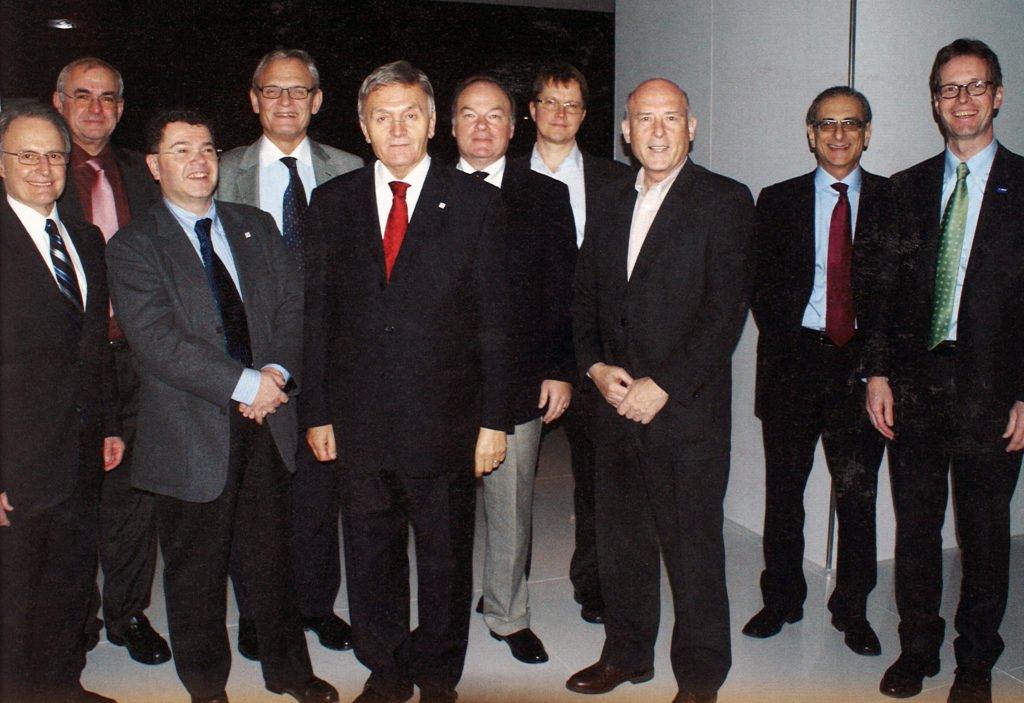
2009年的最初会议诞生出 ITAtech 论坛. 从左到右: Bill Hansmire, Gerhard Robeller, Olivier Vion, Gunnar Nord, Martin Knights, Brian Fulcher, Pekka Nieminen, Lok Home, David Caiden, Daniel Ruckstuhl
当我说到卑尔根代表今年,很明显, 软土城市地质隧道欠掘进机在过去的40年的发展…特别是过去10年。我们现在可以做一些以前很难做的事情。在过去的50年里,像罗宾斯、洛瓦特、塞利、赫伦克希特等掘进机公司领导的创新,并不是巧合,领导力和开拓精神只能由来自“家族经营”业务的个人激情驱动。随着时间的推移,增长和所有权已经被传递,但在隧道里的创新的管理和精神仍然存在。ITAtech试图捕捉这种精神。它的指导委员会和活动团体的成员依赖于工业对教育、改进和分享的渴望
最近,英国土木工程师协会(UK Institution of Civil Engineers)的一位总裁将我们分散的行业流程与制造业、飞机和汽车行业进行了比较。实际上,他说“与那些行业不同——我们是否从装配、安装和构造中分离了初始、规划和设计?”“基础设施和采矿业依赖如此多的流程和伙伴关系,因为它们是如此分散和孤立。
当代的采购鼓励了更多的伙伴关系,但这并没有使它变得不那么复杂。我们看到的可怕的“行业供应链”和“第二和第三层伙伴”,它给我,我们去除的身份非常多“层”的行业创新和提供物质滋养功能在新的基础设施发展的技术解决方案
我建议业主和客户从这些创新的“层级”中获得更好的收益和价值,在许多情况下,设备制造商和供应商。在很多情况下,我看到技术解决方案被误解为想法和解决方案在所谓的供应链上上下移动,乞求承认、理解和实现价值
我相信这不是有意…但它发生。通过验证并通过ITAtech等组织将创新引入前沿,我们可以改进一些复杂的采购和技术审批流程。然而,如果我们想继续看到最近几十年在城市软土地质隧道中看到的进步,我们应该设法简化制造业和采购,并与所有的“层级”密切合作,包括第二、第三、和其他层级。
采矿业新趋势:采矿业的掘进机设备
TBMs have become well accepted in civil construction tunneling and excavate a high percentage of civil construction projects each year. But each year in the mining industry, far more kilometers of tunnels are excavated for mining purposes than for civil purposes. The amount of tunnels needed for mining operations is staggering.
Some examples from metal mines:
- A large, deep gold mine has over 800 km of tunnels. That is a single mine!
- One small underground metal mine excavates over 13 km of tunnel each year
- In the Sudbury, Ontario mining district, there are over 5000 km of mine tunnels
If tunnels for coal mining were included, the statistics would be even more dramatic. But all these tunnels hold a little-known secret.
The Lack of Mechanized Tunneling
How many of the above thousands of kilometers of mine tunnels do you think have been excavated by TBM? The answer is “Nada”. Compare that to the thousands of kilometers of civil construction tunnels built over the last decades, which required hundreds of TBMs. Why such a great disparity when the objective in both industries is to excavate underground openings as rapidly, economically, and as safely as possible? What are the differences in these industries?
In TBM civil construction, the TBM crew members that know how to make things happen underground, that know how to drive the machines, how to lift heavy components and repair the equipment, how to get the trains in and out to remove the muck and to bring in supplies, are known by a special name. They are known as the “miners”. Yet the only thing they are mining is the muck, no coal, no minerals. But “miners” is a term of reverence for someone who knows how to excavate a tunnel rapidly and efficiently. When a civil tunnel is progressing well, they say “now we’re mining”. (Well, sometimes they also say this sarcastically sometimes when things are going poorly underground.) Why aren’t such talented miners, who know how to make a TBM perform, using their TBMs to excavate thousands of kilometers of mine tunnels each year? What are the differences between civil tunneling and mine tunneling?
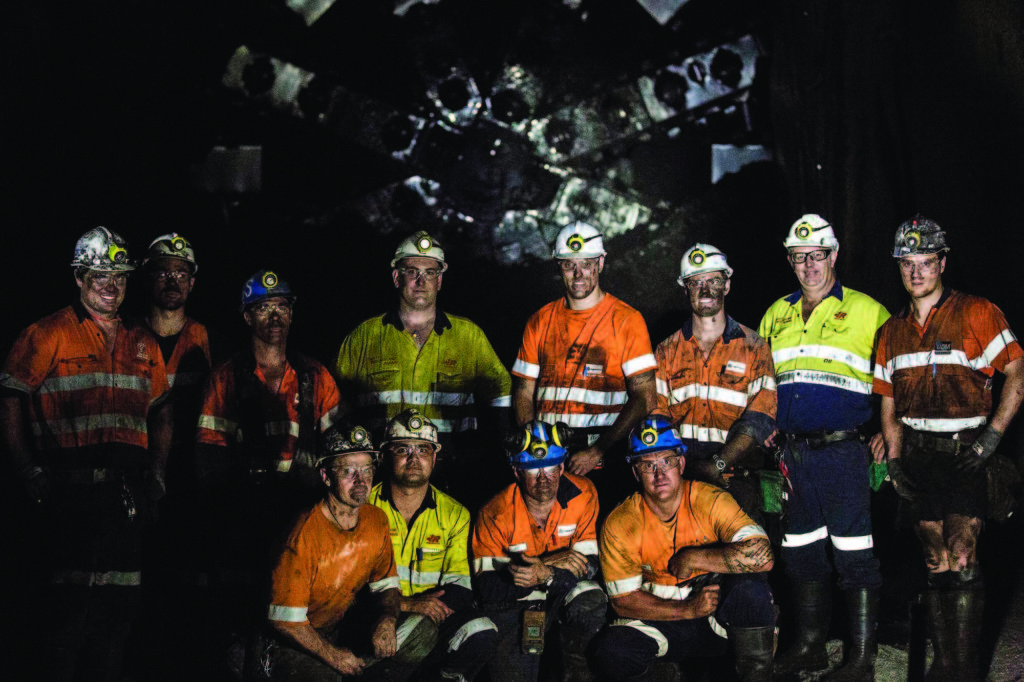
A group of talented miners at Australia’s Anglo American Coal Mine, where a Robbins Crossover TBM excavated two drifts for haulage and personnel access.
TBMs for Civil Tunnels
TBMs have become well accepted for civil tunneling. TBMs designs have become widely adapted for different ground conditions or specialized applications: Hard rock, soft ground, mixed face, pressurized face. Various types of ground support can be installed, according to current geological conditions. More current “hybrid” or “Crossover” TBM designs can handle widely different geological conditions, with the TBM adaptable to cope as conditions change.
Civil tunnels are generally long tunnels, where the efficiency of TBM excavation offsets the longer mobilization and demobilization times. And civil tunnels are generally designed with equipment mobilization/demobilization in mind. Suitable sized shafts are located to allow relatively simple introduction or retrieval of the TBM equipment. The most efficient type of TBM is the full face, rotary type TBM, which produces a circular tunnel profile. The circular profile is nearly universally accepted for civil construction. It is the optimum profile for fluid flow for fresh water, waste water, or hydro tunnels. It is also widely accepted for vehicular civil tunnels that need a flat roadbed. A flat roadway is constructed within the circular tunnel profile and the remainder of the profile within the circle is used for ventilation, services, escapeways, etc.
Some efforts have been made to develop non-circular profile TBMs for the civil sector. These machines include the Mini-Fullfacer, the Mobile Miner, and horseshoe shaped shields with excavator boom or roadheader. Such machines may produce a non-circular profile that is better for that specific job. But usually, there is a penalty in production rate compared to full face, circular TBMs.
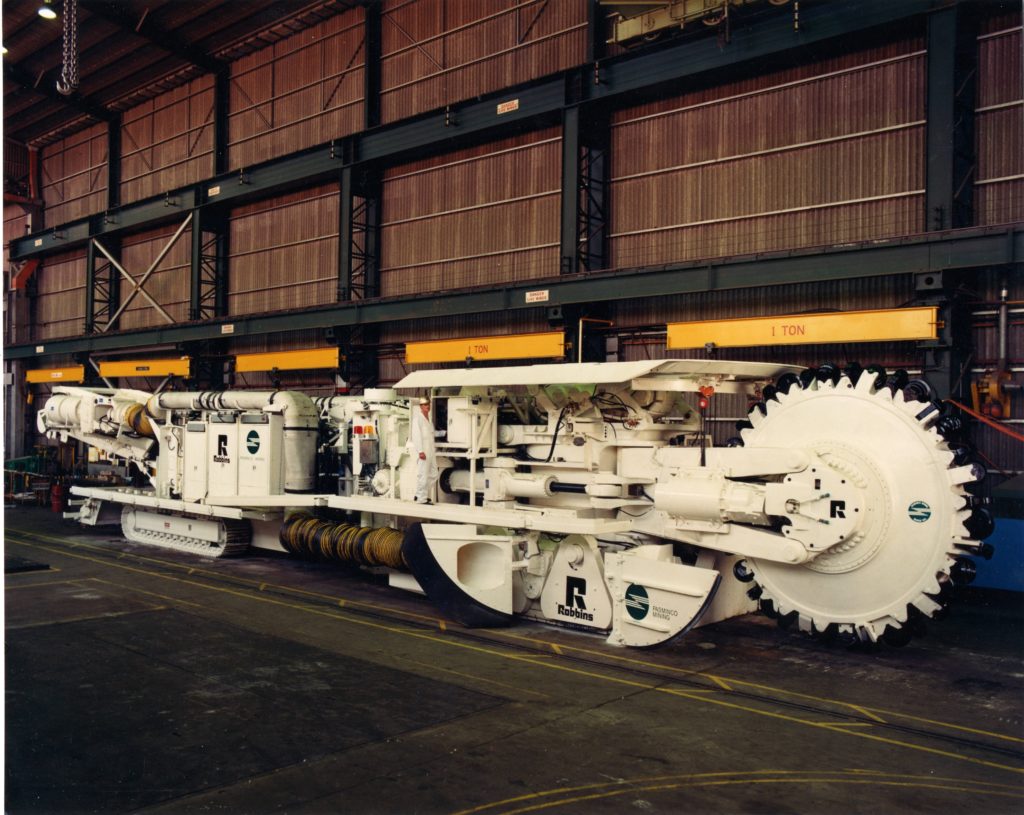
The mobile miner, a non-circular profile TBM developed by Robbins.
TBMs for Mine Tunnels
There have been some notable successes to the application of circular profile “civil type” TBMs for mining projects. Benefits have been lower costs, quicker access, and improved safety. Some examples include:
- Magma Copper, San Manuel Tunnels
- Stillwater Mines (four TBMs used)
- Grosvenor Coal Mine, Two Inclined Access Drifts to the coal seam
However, application of TBMs for mine tunnel construction has remained surprisingly limited. Why is this? Tunnels for mining are often not so long, or a developed in shorter phases, with the excavation front moved from place to place within the mine. TBMs and their constituent components are large and heavy. It is not easy to mobilize a TBM deep underground in a mine at a remote face. Better efforts must be made to make TBM transport and mobilization within the mine practical. This includes considerations for steep ramp roads and other restricted cross sections within the mine.
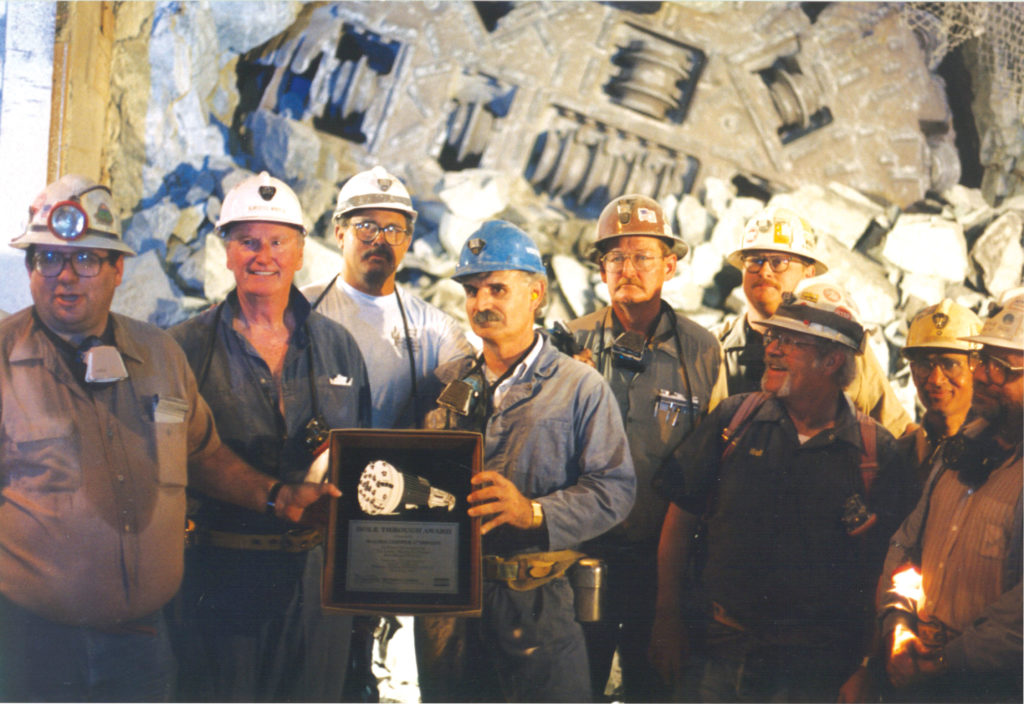
Breakthrough at the Magma Copper Mine in the 1990s.
Efficient TBMs are highly productive, but require a lot of power, ventilation, cooling, and support services. These need to be part of the mining plan so that the TBM has the necessary support and can provide the full benefit. Operating personnel with proper skills are also essential. If a TBM is introduced into a mining environment, either the mine personnel need proper TBM training or motivation, or the TBM drive must be isolated as a “stand alone” operation within the mine and be given proper priority of skilled personnel and the necessary services so the full benefit can be realized.
Mines often do not accept the circular profile produced by the most efficient, full face rotary TBMs. Mine tunnels are usually designed with a flat invert to allow for passage of rubber tired vehicles during the production phase of the mine tunnel. Many efforts have been made to provide TBM type equipment that produces a flat invert. Some have been relatively successful. But generally these machines do not provide the same productivity of efficient, full face circular profile TBMs. Rail bound mining vehicles can be used in the circular tunnel to take advantage of this TBM efficiency. Or, precast invert slabs, poured in place concrete, or partial invert filling can be used in a circular tunnel to provide a flat roadway. The cost/benefits must be analyzed and presented to the industry for a change to occur.
Mining plans often have tunnels with steep gradients and sharp radius curves. On steep gradients (up to 12-15 degrees), the most efficient haulage is usually by belt conveyor. However, the belt system is not effective if there are sharp radius curves. And typical TBM curve ability is limited. Special TBM designs can be made that allow for excavation in sharp curves, but there is a compromise in reduced TBM performance.
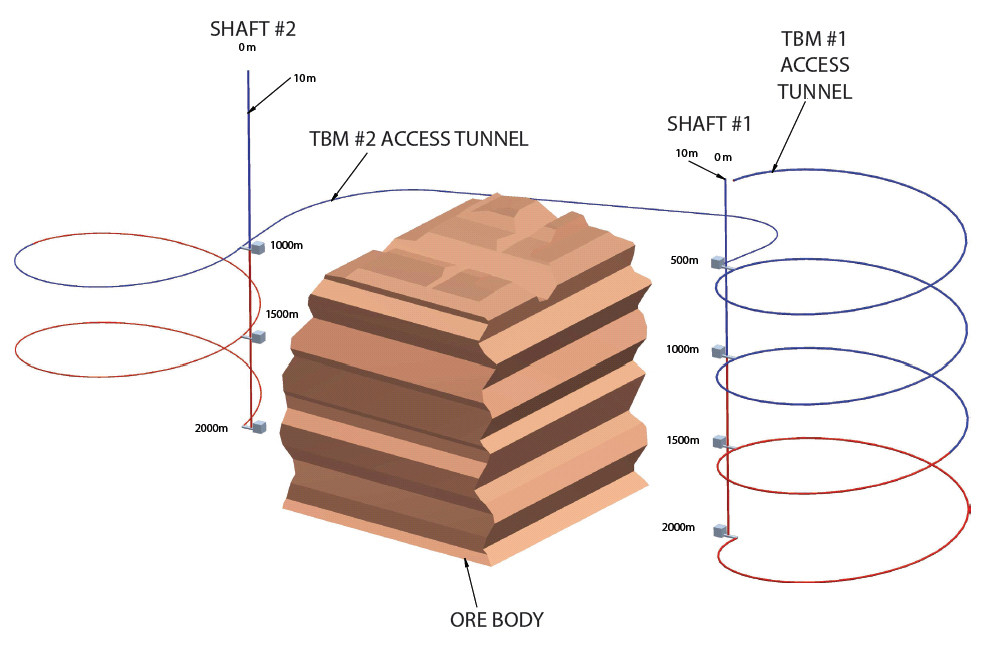
An example of a mine access and haulage plan to reach a deep ore body.
Mines need Versatile TBMs
It seems the mining industry needs the benefits that TBMs can provide. Open pit mines are becoming depleted, and mining activities are reaching deeper. Longer access tunnels are needed. Safety and speed of development are paramount. TBMs can offer these advantages, but have limitations. Special TBMs can be developed that meet special requirements, but usually there is a penalty in reduced TBM performance. The mine planners and the TBM equipment designers must work together at an early stage in the mine planning to determine the optimum compromise between most desirable mine plan, and most beneficial application of TBM equipment. A good partnering approach is necessary in the planning stage, as well as the operating stage, to allow for the most efficient application of TBM equipment to the needs of the mine.
By Dennis Ofiara, Chief Engineer
从风险规避到风险降低:伊隆·馬斯克如何开创隧道掘进的新纪元
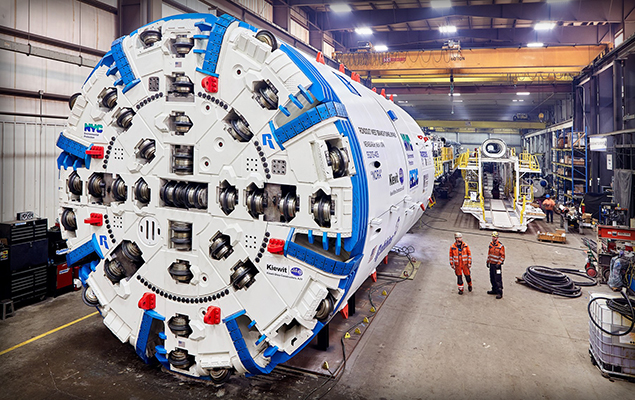
Tunnel boring machines like the one here, for New York’s Delaware Aqueduct Repair, are turning risk aversion on its head.
It has been some time since I have written on the Robbins blog page, but I am inspired to do so by the announcement that Elon Musk is entering our business—the tunnel boring business. It is great to see people with a vision of an improved world enter our industry. I agree with Musk that the advance rate of tunnels can be significantly improved if development money comes into the industry. Development money in tunneling, however, is at best minimal and is more often essentially nonexistent. Nearly all tunnels are heavily specified to avoid risk taking by owners (therefore discouraging new development). Nearly all tunnels go to the low bidder and low bidders try to buy the TBMs at the lowest price; a further discouragement of development. The industry has therefore been slow to improve advance rates, but with Musk bringing the issue into the spotlight, perhaps things will change.
Risk Aversion and How to Reverse it
There are some exceptions to this practice of risk aversion for new technology, and one is the Delaware Aqueduct Repair. This tunnel corrects heavy water leakage occurring from the 1940’s-built aqueduct tunnel for New York City. We are just completing Factory Acceptance in our plant in Solon, Ohio of this unique Single Shield TBM. The tunnel is at significant depth (approximately 300 m / 900 ft) with the distinct possibility of encountering very high water pressure (up to 30 bars). The contractor JV of Kiewit/Shea have shown their willingness to move forward with several new developments for this project. The concept of grouting off high water pressure as the primary means to allow advance in such conditions, rather than use an EPB or Slurry TBM, is in my view a significant step forward for our industry. Granted there have been halfway attempts with a combination of grouting and pressurized tunneling at recent projects like the Arrowhead Tunnels and Lake Mead Intake No. 3, but these have come at high cost and sometimes long delays. The Delaware Aqueduct TBM, by contrast, is designed to hold up to 30 bars of pressure while grouting occurs. Boring and cutter changes are done in atmospheric pressure.
Chemical grouting and grouting technology in general have advanced multifold in recent years, and it is commendable to see it used extensively on several aspects of the Delaware Aqueduct Project. It’s a great example of what can be done when a contractor is willing to use new technology to address potential risks—it appears it can actually reduce risk in the long run. It is a great honor to be working with the capable Kiewit/Shea JV team to be a part of advancing technology.
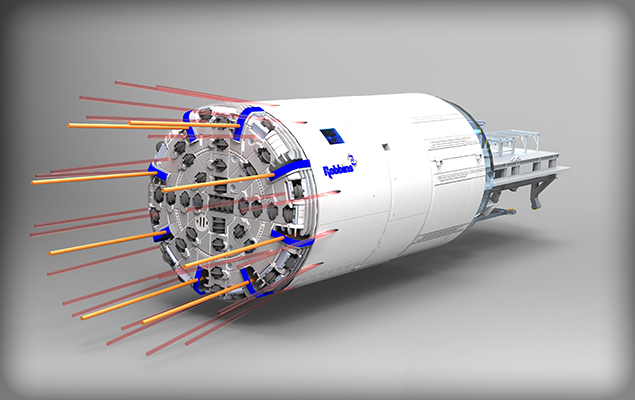
The enhanced probe drilling and grouting capabilities as seen in trajectories (orange and red) on the Delaware Aqueduct TBM 3D model.
Areas Ripe for Change
The Delaware Aqueduct Repair project is a flagship project for what I hope will become more common in the industry: instead of low bidding with the cheapest possible machine, offering a reasonable bid with a specialized TBM that has a higher initial investment, but ultimately a lower cost overall. The project’s use of technology is wide-reaching, particularly atmospheric cutter changes and chemical grouting, which have the potential to reduce downtime and increase safety. I do not see the future of rock tunneling under high water pressure being left to divers to change cutters and repair the cutterhead. We all know it is not cost effective to send divers to work in confined spaces over 10 bars. It should be noted that the long-duration Hallandsås Tunnel, for example, finished the majority of its TBM advance by relying on effectively this technique of grouting and advance after failing with a Slurry System. There are lots of tunnels to be built with above 10 bars pressure that will use this technology. The industry needs to automate cutter and bit changes as much as possible, and increase the integration of chemical grouting in tunneling.
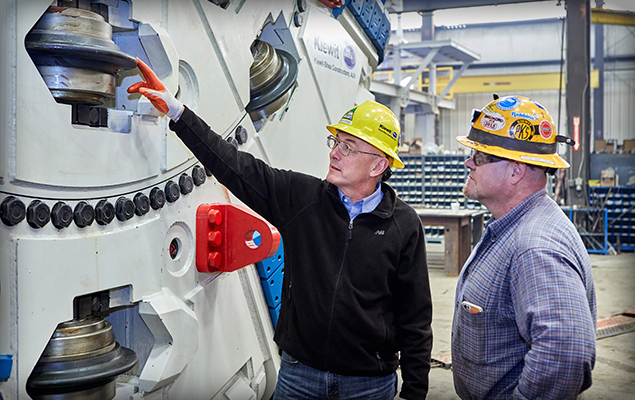
Niels Kofoed and Danny Smith of contractor Kiewit examine the cutterhead and cutters of the Delaware Aqueduct TBM. The machine can bore and cutters can be changed at atmospheric pressure.
Certainly there are many areas for advancement in our industry, and major public figures like Musk drawing attention to it is ultimately a good thing. After all, getting the general public to think about solving traffic by going underground is no easy feat. Even more so, getting the tunneling industry to think about its own risk-averse practices has a big potential benefit. Hopefully all of this attention will result in more tunnels, more business, and better infrastructure. Musk’s willingness to take a risk aimed at making the underground construction industry potentially faster and more stable is a good bet to take.

 Close
Close  Menu
Menu 